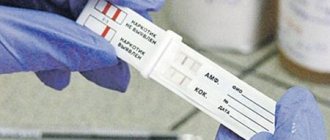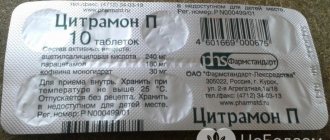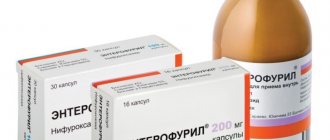Anonymously
Around the clock
Article prepared by an expert
Knoblokh Ekaterina Sergeevna
Leading psychologist of the Center “Zdravnitsa” Medical psychologist, full member of the OPPL, emotional-imaginative therapist. More than 10 years of experience
Read in the article:
- How to determine the presence of amphetamine in the body.
- How long does it take for amphetamine to leave the body?
- How long does amphetamine stay in the blood?
Amphetamine is a synthetic central nervous system stimulant that has a stimulating effect on the psyche. It was first synthesized in the 18th century. Later in 1920, cough and asthma medications were developed based on the psychoactive substance. Then in 1937 amphetamine salts appeared in tablet form. They have been used to treat depression, narcolepsy and even Parkinson's disease.
When used in a minimal dosage, amphetamine can increase energy levels, which is why it is used by truck drivers, students, and athletes. A person feels an increase in vigor and strength, which has a positive effect on overall performance. Athletes manage to achieve new results, so the tablets are used before competitions. Amphetamine is prohibited in sports because it is doping. Truckers use a psychostimulant during long journeys (more than 24 hours on the road). This is how they fight sleep and increase their income.
Usage
There are almost twice as many men who use amphetamine as women. Who uses the drug and for what:
- Women always try to watch their figure and can take amphetamine to lose excess weight. It also helps get rid of fatigue;
- This drug can be taken to increase vitality. People involved in sports can take to cope with increased physical activity;
- The drug is also taken to enhance one's attention. During a business trip, it can be taken to combat sleep;
- The main group is drug addicts. People who also use other types of drugs;
- Teenagers can also try amphetamine simply to experience unusual sensations, without thinking about the harmful consequences of use.
Traditional methods
Many drug addicts who decide to get rid of addiction do not want to turn to narcologists for various reasons. Some are afraid to register with a drug treatment clinic, others do not want strangers to know about their condition, and others simply cannot find the willpower to admit their addiction. As a result, such patients begin to look for folk remedies for getting rid of drug addiction. But not everything is simple here.
At the moment, there is no evidence that any folk method can help cope with Amphetamine addiction. The use of medicinal herbs, baths, and meditation can provide a temporary effect, but cannot cure drug addiction. For example, it is known that to speed up the removal of Amphetamine from the body, you need to drink a lot of water.
Drinking diuretic liquids such as green tea is considered most beneficial. Milk also helps remove toxins. But their effect can be felt if the dose of Amphetamine was minimal. If addiction has developed, folk remedies will not help and will not stop the development of the disease .
Do not delay contacting doctors. The faster they come to help, the greater the chance of a full recovery.
Action
Immediately after taking it, amphetamine quickly spreads throughout the body and is absorbed without residue completely into the human stomach. If the drug is used through a “needle”, its effect begins instantly, entering the brain. In cases where a person can inhale the vapors of this drug, it also enters the bloodstream and other human organs very quickly.
Amphetamine breaks down. This process mainly occurs in the liver. There, amphetamine is divided into ephedrine and other substances. The level of amphetamine in the blood lasts from 8 to 12 hours. If the person immediately receives another dose of the drug the next day, its blood levels are maintained. A person prolongs the effect of the drug. Finding the intake of the drug in the body is very simple. Since the kidneys are involved in the process of removing the drug from the body, it can be detected when submitting urine for analysis.
Treatment in hospital
A set of medical procedures aimed at cleansing the body of Amphetamine is called detoxification.
It can be most efficiently organized in an inpatient setting, where all procedures will be carried out under the supervision of doctors and it is possible to use the entire arsenal of tools available in a drug treatment clinic to treat the patient.
Detoxification is the first stage of Amphetamine therapy, providing the following effects:
- normalization of liver function;
- withdrawal of Amphetamine and its breakdown products;
- improving oxygen supply to the brain;
- mental stabilization.
In severe cases, hardware blood purification is prescribed. For example, plasmapheresis. This process involves filtering the addict's blood through a system of membranes that trap amphetamine and other toxins. Sometimes doctors clean a patient’s blood using the hemosorption method using special sorbents in the form of a liquid. Hardware therapy is carried out only in a hospital setting and takes 4-5 days .
The detoxification procedure allows you to stop physical dependence on Amphetamine. The person feels significant relief. But this does not mean that he is healthy. A huge influence on the behavior of a drug addict is exerted by an altered consciousness, the attitudes of which will always push him to use Amphetamine.
Therefore, the next stage of treatment is working with a psychologist and psychotherapist. It is organized individually and in groups. The process of reformatting the psyche and consciousness of dependent patients takes a lot of time.
The success of treatment will largely depend on the patient’s positive motivation to completely quit drugs, the restoration of his personal qualities, and a sense of responsibility for his actions.
Influence
The use of the drug does not leave its mark on the body. Every time you use it, one or another organ is involved:
- CNS (central nervous system of the body):
- concentrates attention;
- reduces body fatigue;
- increases performance;
- decreased appetite;
- sleep disturbance;
- activity increases;
- improves mood;
- the onset of trembling throughout the body;
- convulsions are possible;
- psychoses begin to develop.
2. Cardiovascular system:
- the appearance of arrhythmia;
- various heart failures;
- the number of heartbeats increases;
- the appearance of pain in the heart area.
3. Gastrointestinal system:
- diarrhea;
- the appearance of strange tastes in the mouth;
- nausea occurs;
- vomiting may occur;
- persistent aversion to eating;
- loss of appetite;
- rumbling in the stomach and pain.
4. Endocrine system:
- Women may experience pain in the mammary glands;
- various manifestations.
5. Kidneys: frequent urination.
The essence of the drug
Most amphetamine lovers are young people who are avid nightclub goers. The drug actively affects the central nervous system, stimulating it and helping young people relax and dance the night away. Students also do not give up amphetamine - the stimulant helps them sit at night studying textbooks and preparing for sessions.
Despite the widespread myth about the relative safety of this light drug, amphetamine causes persistent addiction and negatively affects the functioning of internal organs, causing the development of serious pathologies.
The main effect of this drug is the active stimulation of the production of organic hormones: adrenaline and norepinephrine. Their excess amount in the body provokes a strong constriction of blood vessels, an increase in the concentration of sugar in the blood .
How does amphetamine work?
This effect is considered beneficial in the treatment of bronchial asthma and serious allergic manifestations. But medicine has long abandoned the use of amphetamine in treatment plans: a person, freed from one pathology, acquired a lot of other negative consequences.
Consequences of use
The use of amphetamine stimulates virtually every part of the brain and accelerates the functioning of the entire nervous system. Due to this, the body has to spend its accumulated energy and psychological resources. Huge expenditures of energy tear apart the human body. After all, a person can stay awake for days, dance for hours, but still not feel the least bit tired.
A person’s attention increases, any self-doubt disappears, the feeling of fatigue goes away, appetite completely disappears and prolonged insomnia occurs. All this happens due to the release of dopamine, norepinephrine and adrenaline in the body.
The production of dopamine and adrenaline leads to an increase in heart rate and blood pressure. Arrhythmia occurs, blood flow to the brain increases and intracranial pressure increases.
If a person takes the drug repeatedly, and also increases his dosage, then convulsions or loss of consciousness may occur. Psychosis may develop suddenly. If a person takes the drug even for the second time, the body begins to develop an addiction to it.
If a person does not take the drug the day after use, he develops depression. High fatigue of the body immediately sets in and a feeling of dissatisfaction appears. In the future, to achieve euphoria, the dosage of the drug will have to be increased.
Effects of amphetamine
The substance acts directly on the brain, so the symptoms of intoxication differ in their strength and duration. In this case, the following effects are realized:
- Central. Associated with changes in consciousness, mental status, the appearance of hallucinations and movement disorders.
- Peripheral. Based on the involvement of autonomic structures and activation of adrenergic receptors in all tissues. Characterize physical symptoms.
Amphetamine differs from other drugs in its high neurotoxicity. Large doses of the substance irreversibly damage brain cells, especially in children and adolescents. The effects of the drug are so pronounced that the first signs of addiction appear even after irregular use.
What happens after
After taking amphetamine, a person experiences a persistent headache. Limbs may begin to tremble. Aggression and fussiness appear. Paranoia may also appear. Sleep disappears, it is difficult to concentrate and collect oneself, and therefore various mental disorders may begin to develop.
“Amphetamine psychosis” occurs in people who take amphetamine on a regular basis. This condition can be described as a manifestation of hallucinations in humans. Later, signs of depression appear.
With prolonged use of the drug, vomiting, nausea, and diarrhea may occur. Appetite disappears completely due to which sudden weight loss occurs. Leads to the fact that the risk of stroke increases significantly.
After using amphetamine, a person’s face turns red, their head begins to hurt, and the release of sweat from the body increases. Leads to a decrease in potency. Pain or heart failure may occur. The heart rate increases and blood pressure rises. It can lead to cardiovascular failure.
Unpleasant consequences appear in the gastrointestinal tract: rumbling in the intestines, diarrhea, nausea, aversion to food, vomiting and abdominal pain. When taking large dosages, a person may fall into a coma.
Taking amphetamine is dangerous for people with diseases of the cardiovascular system (coronary disease, arrhythmia, high blood pressure, etc.), glaucoma and hypertriosis.
Composition of amphetamine
Pure amphetamine is the prerogative of pharmaceutical companies. In illegal circulation, the concentration of the active substance in the finished product is 45-50%. The remainder is filled with cheaper impurities or other psychotropic compounds.
Combined drugs of synthetic origin are now common. Amphetamine-type substances (AAR) are synthesized everywhere, since there is no geographical reference to the raw materials (precursors) used. In addition, underground manufacturers do not bother with chemical cleaning of the product - toxic additives (for example, acetone or industrial solvents) enhance the negative effects.
How to spot signs of use
The main signs of amphetamine use include psychological disorders in a person. People who have overdosed usually have good spatial orientation and a clear mind.
Signs of an overdose include:
- cardiopalmus;
- blood pressure levels rise sharply;
- cardiovascular failure;
- seizures, as in epilepsy;
- pupil dilation.
Symptoms of psychosis include: manifestations of paranoia, hallucinations (all types), a person’s thinking is similar to delusions. At the same time, a person’s orientation remains at the usual level, as does his memory.
Factors affecting the elimination time of a substance
Calculating how long amphetamine lasts in urine should begin by collecting some information about the person who used the drug. The main factors in this situation are considered to be the volume of the drug dosage, the general health of the person and his history of using amphetamine.
In addition, the duration and frequency of recent use is important. The rate of elimination will be greatly influenced by this factor: a single episode or use over a certain number of days, weeks or months.
What to expect after use
After taking the drug, various symptoms appear when it is discontinued (especially if the drug was taken for a long time).
At first, from 9 hours to 4 days, a severe blow to the body occurs. There is a persistent desire to use the drug in order to relieve the consequences of withdrawal: paranoia, depression, psychosis.
From 1 to 10 weeks there is a withdrawal syndrome. The desire to take the drug gradually subsides. Sleep is already normalizing. But the mood is still depressed and the feeling of anxiety does not go away. The desire to take the drug may be weak and increasing.
From 10 weeks to six months, the extinction phase occurs. The mental state gradually returns to normal. In large companies, during celebrations or parties, there may be a desire to break loose. Especially when drinking alcohol.
Methamphetamine is more popular
Despite the more pronounced toxicity of methamphetamine, the drug is more popular. It is due to the relative cheapness of the substance and ease of manufacture. Its effect is similar to cocaine, but in terms of duration of exposure (12 hours or more) it significantly exceeds the latter. In America, methamphetamine is called "poor man's cocaine."
Amphetamines are still common in psychotherapeutic practice, and they have retained their “military” significance, as they continue to be included in the first aid kits of US Army special forces. The drugs are produced by numerous companies around the world, although according to the World Health Organization classification, amphetamines are classified as drugs.
Every drug addict is sure that his drug is safe for life. And methamphetamine is no exception. However, photos of people who are addicted to “ice” fully reflect the depth of this misconception. Unhealthy thinness, haggard pale faces with skin affected by ulcers - in a word, living half-corpses. You don’t need to talk much about it – just seeing it once is enough to never even think about drugs. And for those who once set foot on this winding path, only an experienced narcologist and treatment in an appropriate clinic can become salvation.
How to help a person
If a person has taken a drug, it is necessary to induce vomiting to clear his stomach. Next, you should use activated carbon. If a person did not have time to provide first aid, hospitalization in a hospital is not ruled out.
If a person has a desire to take the drug, it is worth removing all dangerous objects that may be stored in your home away from it. Make sure that his breathing is uniform and that he does not bite his tongue. In case of vomiting, it is worth placing the person on his side to avoid the possibility of swallowing masses.
It is worth remembering that drugs like amphetamine give a person energy. But due to this, the body’s own energy is actively burned and completely exhausted.
Treatment conditions at the BALANCE clinic
Amphetamine is a drug of choice for young people. Its action may seem attractive and harmless. But it won’t be long before drug addiction becomes a heavy burden for you and your family. If trouble has come to your home, contact the narcology department of our clinic by calling +7(495)215-27-03 and undergo a course of treatment.
A hospital is not a prison , as some drug addicts think. Our patients are accommodated in convenient and comfortable rooms and do not feel limited in their freedoms.
The only obligatory condition for treatment is adherence to the daily routine, compliance with all doctor’s orders and complete abstinence from psychostimulants.
In their free time, patients can watch TV, use the Internet, read books, go to the gym, and take a walk. Only complete mutual understanding between the doctor and the patient will ensure the success of therapy. We are ready to work with the most severe cases of addiction, and we guarantee recovery if the patient cooperates with our doctors.










